In a recent presentation at the Astronaut Auditorium, renowned trader Devon shared insights into his XAUUSD strategy, demonstrating how he achieved $11,000 in profits within a month. Devon, who primarily focuses on Bitcoin and Gold, emphasized that his strategy is versatile enough to be applied across various markets, including forex pairs such as EUR/USD, GBP/JPY, and GBP/USD.
Devon attributed his trading success to a disciplined approach, particularly in managing his sleep schedule, which he sacrifices in favor of maximizing trading opportunities. His methodology blends meticulous analysis with a hands-off approach, depending on market conditions.
His trading schedule is notably irregular, often involving early morning sessions and late-night monitoring. This adaptability has enabled Devon to transition into full-time trading, frequently earning up to $1,000 per day.
Strategic Insights on Trading Bitcoin and Gold
Devon’s approach to trading Bitcoin and Gold is both methodical and profitable, capable of rapidly growing an account. For Bitcoin, he recommends stacking positions at key consolidation points—areas where the price stabilizes after significant movement. These positions can be left to run throughout the day, as the likelihood of profit increases once the market begins to move.
In contrast, Gold trading demands constant vigilance. Devon’s strategy requires active monitoring, sometimes involving extended trading sessions. The payoff, however, can be substantial, with opportunities to conclude trades profitably early in the morning.
Best time frames to open a position
Identifying the ideal time frames to open a position is central to Devon’s strategy. This involves recognizing range-bound pricing behaviors and the ability to switch between time frames to adapt to market dynamics. Devon shared his approach in a podcast with Antonio, where he emphasized the importance of marking high and low points on the 4-hour chart using rectangular tools to identify significant price levels.
When I trade, I start by marking up the high and low on the 4-hour chart using the rectangle tool. This gives me a clear picture of the key levels. From there, I look for consolidation zones on the lower time frames—starting with the 1-hour, then the 30-minute, the 15-minute, and finally the 5-minute. If I don’t see consolidation on the higher time frames, I’ll focus on the 5-minute chart. As the consolidation continues, I watch for it to shift into higher time frames, like the 15 or 30-minute charts. This process helps me track the market’s behavior and catch potential breakouts as they develop. I know the consolidation could move across different time frames, so I stay flexible and keep flipping between them to stay ahead of the market.
Consolidation strategy on XAUUSD
So we’re going to have this 4-hour here, just marking up the high and low, and then we’ll drop to the 1 hour. On the 1 hour, we don’t see much of anything other than what happened between the end of yesterday and then from the beginning of Asian London up until this morning where gold started its push back up.
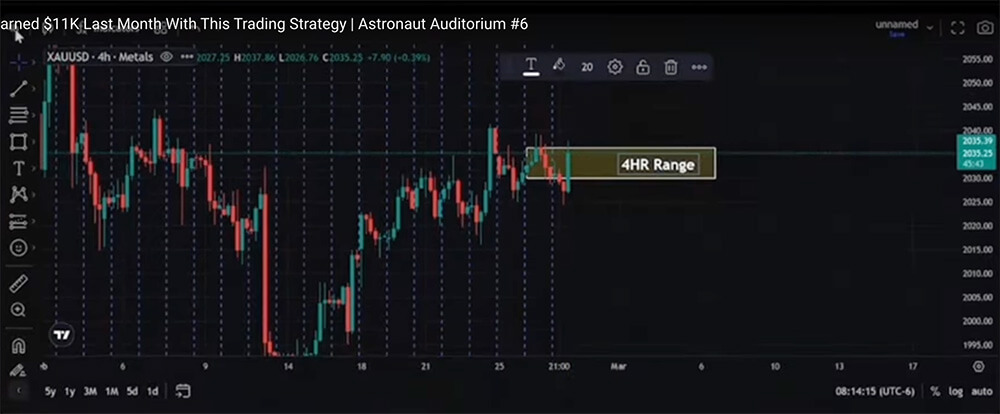
On the 1 hour, we don’t see much of anything other than what happened between the end of yesterday and then from the beginning of Asian London up until this morning where gold started its push back up. So we’re going to mark that up. This way, we’re going to make sure we know this is the 1-hour range.
…no matter how small the zone might be, you’re just going to mark it up.
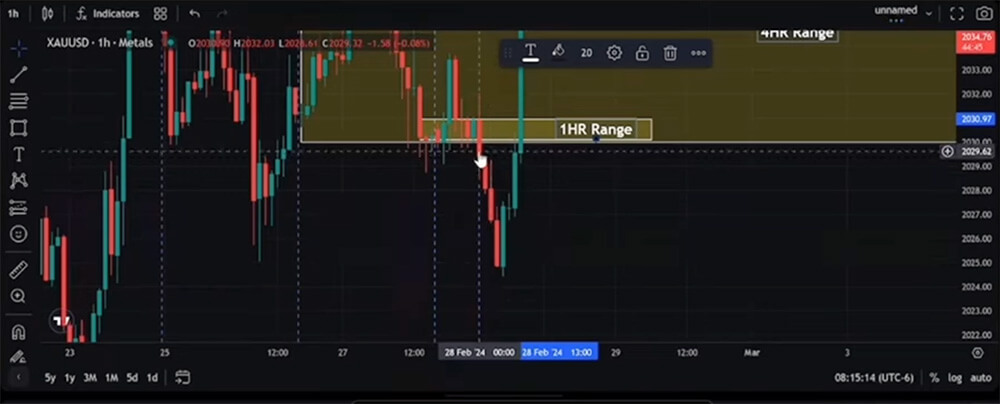
Now the five-minute dropped out of the 4-hour range and the 1-hour range that we drew up. Now, since there was no consolidation on the 30 or 15, and we already dropped out of the 1-hour range, we’re going to look for consolidation on the five minute.
So what’s going to happen is, with what I like to look for for my entries on the 5 minute, we have price coming breaking out of this five minute range here.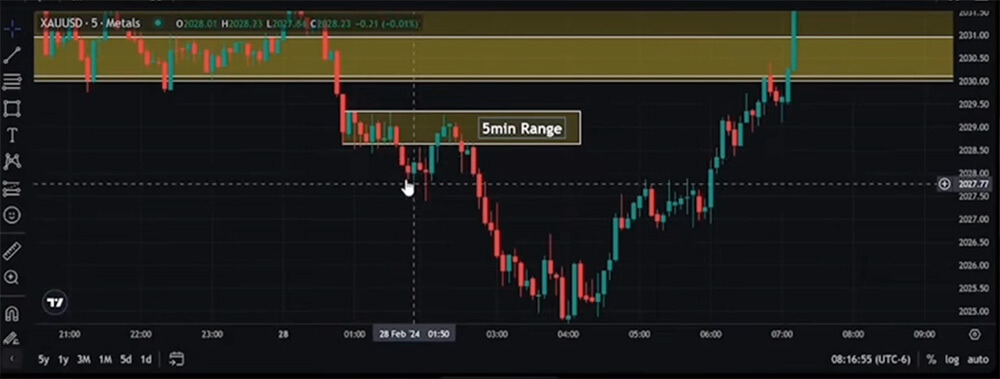
I’m waiting for the structure to be built. I want price to be exhausted. I want price to be exhausted, you see this move that happens right here, this bullish move, this pressure. I’m putting my sell stop here because now we have enough room for error, right?
If price wants to revisit back down to these lows and drop off, it’s going to revisit the lows and more than likely it’s going to drop off. These highs were protected, and this wick here closed below these highs, and the candle also closes below the rest of the range over here. So at that point, I was just, I placed, we were going to place a sell stop here.”
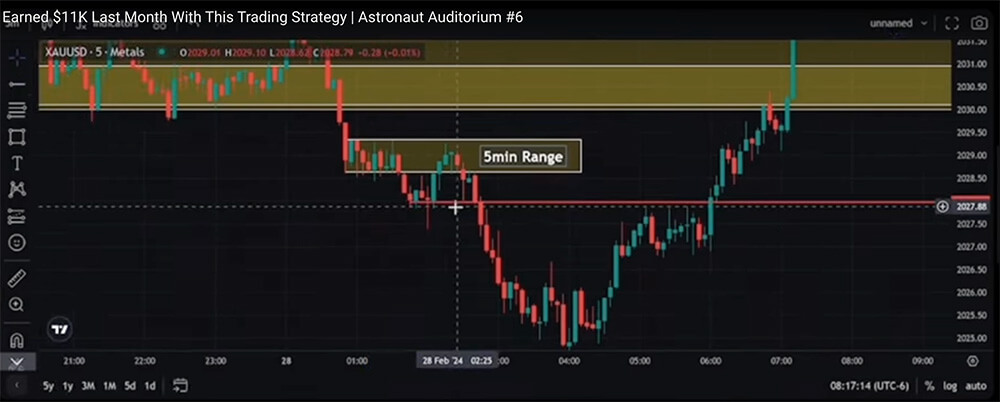
Now, if you want to play the upside, you can even flip it. This morning, I was watching gold do this because I was already up around this time. You can do this here because gold started consolidating.
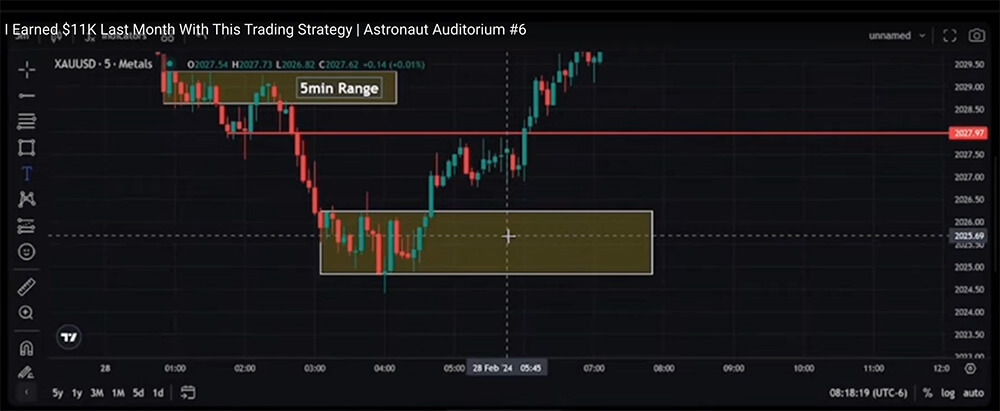
I’m not entering on this breakout. I’m going to wait. I’m going to wait. Now that we waited, we have more consolidation, consolidation after a breakout. I’m going to more than likely set my buy stop up here once I give these candles a chance to come down.
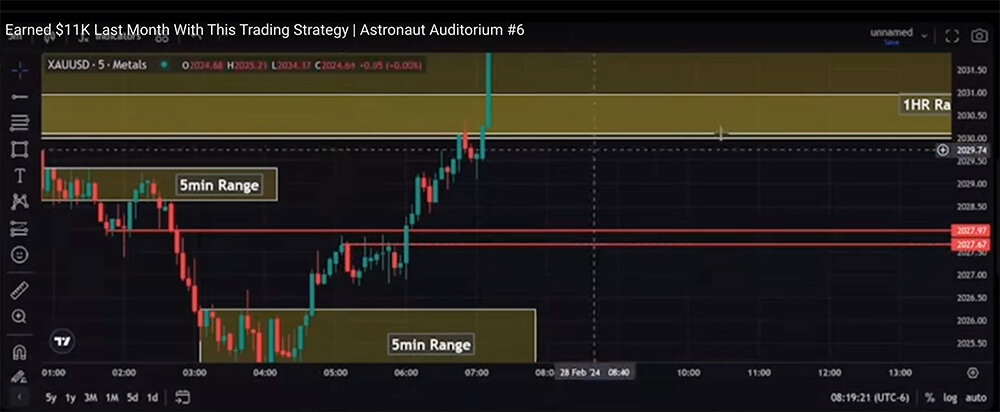
I didn’t even draw it up. Like, the sell side could have played it. And then right there, that whole buy that just happened on gold, that was a perfect entry at 2076.5. Boom, say no more about it, like clean entry, zero drawdown. If you entered, like, if you just set your buy stop, me, my buy stop would have been set after this, so I would have been in drawdown, but it would have been a little bit of drawdown, that’s nothing to worry about.”
What problems do I face in trading?
When it comes to my trading approach, I’ve fine-tuned it over time to a point where it almost feels like second nature. I start by identifying key levels on the 4-hour chart, and then I watch how consolidation develops across different time frames, from the 1-hour down to the 5-minute. If I spot consolidation on the 5-minute, I track it closely as it could extend to higher time frames like the 15 or 30-minute charts, signaling potential breakouts. I prefer trading with two lots, whether straight up or by stacking smaller positions to reach that size. This method allows me to catch moves consistently, and I’ve refined it to minimize drawdowns and fakeouts.
However, no trading approach is without its challenges. The most significant issue I encounter is related to entries. Whether I enter on a retest or place my buy and sell stops at specific levels, there’s always a 50/50 chance of getting wicked into a position only for the price to tank unexpectedly. This risk is inherent in trading, and while I’ve developed an eye for spotting fakeouts and adjusting my bias accordingly, the entry point remains the most unpredictable element. Despite this, I’ve structured my method to avoid major pitfalls, and I’ve built enough confidence in my system that I rarely encounter serious issues. The occasional challenge with entries aside, my strategy has proven resilient and effective in navigating the market’s ups and downs.
The only downside is the whole entry thing, like, an entry, we can argue about it all day, whether you enter on retest or enter on where I place my buy and sell stops, and the reasoning why I place them. I don’t really see much downside to what I do.
I don’t lose very often, and that’s a fact. When it comes to trading, I’ve honed my method to the point where I can confidently say it’s one of the best things I’ve ever put together. I practice what’s often called “naked trading”—stripping the chart down to its essentials, relying solely on price action to guide my decisions. When I wake up and see certain patterns forming on the chart, I don’t hesitate. I box up the consolidation, place my buy or sell stops strategically, and then let the market do its thing. The beauty of this approach is its simplicity and visual clarity. The box makes it easy to see where the price is going, and whether it’s going to consolidate or break out, I’m ready to act.
Sticking to this plan is crucial. If I miss an entry, no problem—I’ll wait for the next one and still make money. Whether I catch a move early or a bit later, I always find a way to profit. This strategy works for me, and it’s allowed me to consistently find opportunities anytime, anywhere. Some traders might not understand why I don’t enter on a retest, but the results speak for themselves. I’ve made five figures this month, and that’s all that matters. This method is not just a strategy; it’s a system I’ve built and perfected, one that gives me confidence and consistent results in the market.
Questions from the Audience
Q: You mentioned finding entries any time of day. Is it easier in the early morning?
A: No, it’s not easier. The time of day doesn’t really matter. Whether it’s midnight or early morning, I can find good trades as long as the setup is right.
Q: When do you usually stop trading?
A: I stop when I sleep. As long as there’s an opportunity, I keep trading. Sometimes, I even let trades run while I do other things, like spending time with my family.
Q: Do you place your rectangles on the wicks or the candle bodies?
A: I place the rectangles on the candle bodies. Wicks tell a story, but for my boxes, I stick to the bodies to avoid getting faked out by minor price movements.
Q: Would you use this entry system on any timeframe?
A: Yes, it works on any timeframe, but I prefer the 5-minute chart because it gives a clearer picture of price action and leads the way for higher time frames.
Q: Is it important to wait for a second entry after a pullback?
A: Yes, I often wait for a pullback before entering. It’s important to have some room for the trade to develop rather than rushing into a position.
Q: What do you do when there’s a fakeout?
A: I wait. If it’s a fakeout, I’ll adjust and set my buy or sell stops accordingly. Patience is key, and I let the price action confirm the next move.
Q: Do you keep track of higher time frames like daily, weekly, or monthly?
A: I don’t focus much on higher time frames unless there’s something significant, like equal highs or lows about to break. I’m mainly a day trader, so I stick to the 4-hour down.
Q: How do you know when a fakeout is happening?
A: You can’t always know in advance. I watch price action closely, and once it happens, I determine if it’s a real breakout or just a fakeout based on how the price behaves afterward.
Q: What does a non-trading day look like for you?
A: There really isn’t a non-trading day for me. Even on weekends, I’m trading Bitcoin. But I do make time for family, especially when the kids are off school.